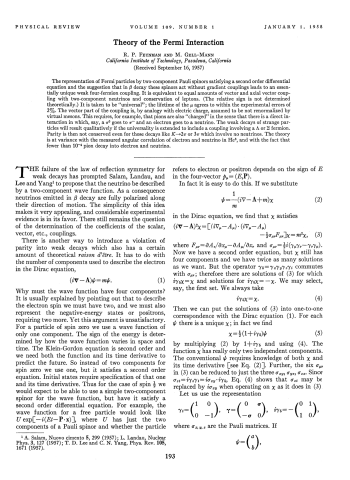Theory of the Fermi Interaction

The representation of Fermi particles by two-component Pauli spinors satisfying a second order differential equation and the suggestion that in P decay these spinors act without gradient couplings leads to an essentially unique weak four-fermion coupling. It is equivalent to equal amounts of vector and axial vector coupling with two-component neutrinos and conservation of leptons. (The relative sign is not determined theoretically. } It is taken to be "universal"; the lifetime of the y agrees to within the experimental errors of 2%. The vector part of the coupling is, by analogy with electric charge, assumed to be not renormalized by virtual mesons. This requires, for example, that pions are also "charged" in the sense that there is a direct interaction in which, say, a ~0 goes to m and an electron goes to a neutrino. The weak decays of strange particles will result qualitatively if the universality is extended to include a coupling involving a A. or Z fermion. Parity is then not conserved even for those decays like E~2x or 371- which involve no neutrinos. The theory is at variance with the measured angular correlation of electron and neutrino in He', and with the fact that fewer than 10 4 pion decay into electron and neutrino.
At the present time several beta-decay experiments seem to be in disagreement with one another. Limiting ourselves to those that are well established, we find that the most serious disagreement with our theory is the recoil experiment in He-6 of Rustad and Ruby x indicating that the T interaction is more likely than the A. Further check on this is obviously very desirable. Any experiment indicating that the electron is not 100% left polarized as x for any transition allowed or forbidden, would mean that (8) and (9) are incorrect. An interesting experiment is the angular distribution of electrons from polarized neutrons for here there is an interference between the V and A contributions such that if the coupling is V—A there is no asymmetry, while if it is V+A there is a maximal asymmetry. This would permit us to choose between the alternatives (8) and (9). The present experimental results" agree with neither alternative.